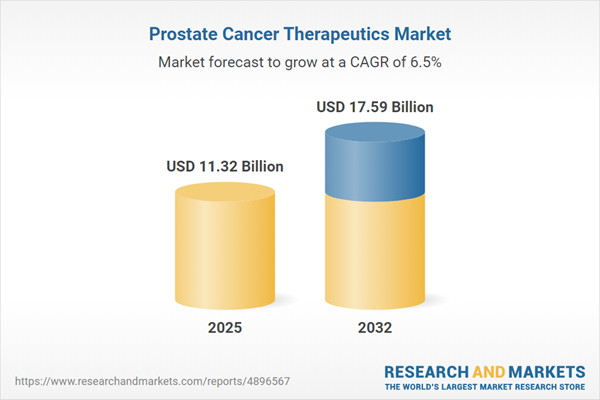Speak directly to the analyst to clarify any post sales queries you may have.
The prostate cancer therapeutics market is undergoing substantial change, shaped by technological advances, regulatory shifts, and evolving care delivery models. In this environment, senior decision-makers need actionable, strategic insights to remain competitive and effectively address patient needs.
Market Snapshot: Prostate Cancer Therapeutics Market
The global prostate cancer therapeutics market is charting steady development thanks to continued research and technological improvements in diagnostics and treatment. Efforts to improve early detection and intervention are driving demand in both established and emerging markets. Pharmaceutical companies now deploy a diverse portfolio of oral and injectable options, enabling greater operational flexibility across care environments. As regulatory landscapes evolve, companies face increased focus on quality, compliance, and patient safety—prompting the need for agile responses and opening the door to new market entrants.
Scope & Segmentation of the Prostate Cancer Therapeutics Market
- Therapeutic Mechanisms: Covered therapies include chemotherapy agents, hormone therapies, immunotherapies, radiopharmaceuticals, and targeted treatments, allowing stakeholders to address differing disease stages and patient response profiles.
- Therapy Lines: Analysis spans both first-line and advanced settings, clarifying how variations in regional clinical guidelines impact treatment pathways and capacity planning for organizations.
- Formulations: Both oral and injectable options are reviewed for their operational efficiency and suitability in hospitals, specialty clinics, and outpatient settings, supporting diverse models of care delivery.
- Distribution Channels: Core channels assessed include hospital pharmacies, retail drug stores, and online platforms, critical for responsive distribution and fulfillment across health systems.
- End Users: Cancer centers, acute care hospitals, specialty clinics, and homecare providers are examined with a focus on accessibility and adaptability across service models.
- Regional Coverage: Geographic analysis includes North America, Latin America, Europe, Middle East, Africa, and Asia-Pacific, exploring variations in regulatory frameworks and healthcare infrastructure that shape local strategies.
- Companies Profiled: Market leaders highlighted are Astellas Pharma Inc., Pfizer Inc., Johnson & Johnson, F. Hoffmann-La Roche AG, Novartis AG, Bayer AG, AstraZeneca PLC, Sanofi S.A., Bristol-Myers Squibb Company, and Merck & Co., Inc., showcasing differing approaches to commercialization and research.
Key Takeaways for Senior Decision-Makers
- Artificial intelligence is enhancing clinical support systems and optimizing treatment workflows, yielding operational efficiency while reducing administrative workloads.
- Innovations in immuno-oncology and radiopharmaceuticals are driving more personalized approaches and shaping care pathways in varied clinical settings.
- A shift toward real-world evidence and value-based procurement is prompting suppliers to adopt adaptable engagement models and operational agility in markets with unique healthcare needs.
- Collaboration among pharmaceutical manufacturers, technology companies, and research institutions is accelerating the pace and reach of therapeutic innovation, improving patient access to new treatments.
- Investment in regional manufacturing and supply chain enhancements has become a priority for companies navigating compliance, entry, or expansion within changing regulatory landscapes.
Tariff Impact: Navigating 2025 United States Policy Adjustments
Forthcoming U.S. tariff adjustments are expected to intensify cost pressures for manufacturers in the prostate cancer therapeutics sector. Managing supply chains efficiently, with a focus on contract management and rigorous quality assurance, is critical for mitigating risk and maintaining regulatory compliance as these policy changes take effect.
Prostate Cancer Therapeutics Market: Research Methodology & Data Sources
This assessment relies on expert interviews with clinicians, in-depth analysis of clinical trial results, and up-to-date regulatory review. A triangulation method is used to validate insights, reinforced by independent third-party sources, ensuring reliability for strategic market planning.
Why This Report Matters
- Guides executive teams in aligning operational strategy with current technology trends, regulatory requirements, and commercial priorities within the prostate cancer therapeutics space.
- Clarifies the influence of regional growth drivers and infrastructure variations, supporting risk evaluation and market-entry or expansion planning.
- Enables robust segmentation strategies for building resilient supply chains and optimizing operational models across diverse regions.
Conclusion
This report empowers senior leaders to anticipate market shifts, identify new growth opportunities, and develop proactive, informed strategies in the evolving prostate cancer therapeutics arena.
Additional Product Information:
- Purchase of this report includes 1 year online access with quarterly updates.
- This report can be updated on request. Please contact our Customer Experience team using the Ask a Question widget on our website.
Table of Contents
3. Executive Summary
4. Market Overview
7. Cumulative Impact of Artificial Intelligence 2025
Companies Mentioned
The companies profiled in this Prostate Cancer Therapeutics market report include:- Astellas Pharma Inc.
- Pfizer Inc.
- Johnson & Johnson
- F. Hoffmann-La Roche AG
- Novartis AG
- Bayer AG
- AstraZeneca PLC
- Sanofi S.A.
- Bristol-Myers Squibb Company
- Merck & Co., Inc.
Table Information
| Report Attribute | Details |
|---|---|
| No. of Pages | 192 |
| Published | November 2025 |
| Forecast Period | 2025 - 2032 |
| Estimated Market Value ( USD | $ 11.32 Billion |
| Forecasted Market Value ( USD | $ 17.59 Billion |
| Compound Annual Growth Rate | 6.5% |
| Regions Covered | Global |
| No. of Companies Mentioned | 11 |









